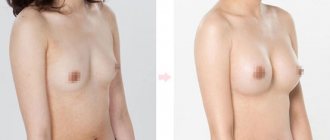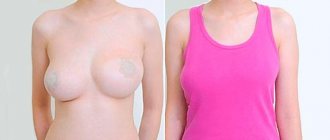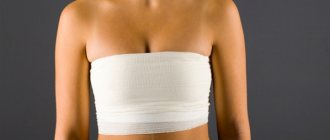» Plastic surgery » Breast reconstruction
- Why is breast reconstruction necessary?
- How can you restore your breasts?
- Breast reconstruction with silicone implants
- Breast reconstruction using your own tissue
- Breast reconstruction using combined techniques
- Reconstruction of the nipple and areola; lipofilling
The mammary gland is a part of the body that plays a huge role in the life of a woman of almost any age. Unfortunately, among female cancer pathologies, breast cancer is the most common event. In some cases, when the tumor is detected in the early stages, organ-preserving treatment is possible, but in most cases, surgical treatment consists of a mastectomy - complete removal of the mammary gland.
Breast reconstruction allows you to restore the appearance of a lost breast and is a very popular technique throughout the civilized world.
In leading clinics, including the Century Clinic, breast reconstruction is performed simultaneously with mastectomy, which allows saving most of the breast skin, and in some cases, the nipple and areola. The clinic uses various methods for breast reconstruction after mastectomy, which, even if it is completely removed in another institution, allows you to restore the aesthetic appearance of the lost mammary gland. This type of reconstruction is called delayed.
Why is breast reconstruction necessary?
Breast reconstruction can help you feel more comfortable and not worry about what you will look like after the tumor is removed. Most women with a removed mammary gland experience significant psychological discomfort; their personal lives often change for the worse due to feelings of self-doubt and an inferiority complex. These effects are especially acute after the end of antitumor treatment, when the fear of the disease goes away and the time comes to return to normal life.
Indications for mammoplasty
Some women have naturally small breasts. In addition, with age, it can lose its elasticity and sag. Mammoplasty will help to immediately and radically solve both of these problems.
In addition to the fact that you can get breasts several sizes larger, the surgeon is able to give the mammary glands any shape.
Breast shape correction using mammoplasty
A woman often faces the fact that after giving birth and breastfeeding a baby, her breasts become flaccid and lose their original shape.
In medicine, these changes are called “post-lactation involution” - when the tissues of the organ are first subjected to strong stretching, and after the milk leaves, ptosis develops, manifested in sagging.
Any woman can determine the signs of ptosis on her own, but it is still better to seek advice from a specialist. Ptosis is usually diagnosed based on the position of the nipple.
If this part of the organ is located lower than the inframammary fold, then they speak of sagging and ptosis. In addition, on a sagging breast, the nipple may completely change position, while looking down.
Mammoplasty can eliminate all signs of ptosis and correct the position of a drooping nipple in one session. Even in cases where the manifestations of ptosis are characterized not by loss of volume, but by simple drooping, there is a way out; instead of enlarging, the surgeon will perform a lift.
How can you restore lost breasts?
Breast reconstruction can be performed using the following methods:
- Using silicone implants
- Using your own fabrics
- Combination of own tissues and silicone implants
There is no “best” way of breast reconstruction. The method is selected together with the surgeon, taking into account the size of the mammary gland, the disease, the treatment performed or planned, as well as the constitution, general health and the presence of bad habits.
Your surgeon should explain to you the pros and cons of each method as it applies to your situation and give you his or her opinion regarding the choice of reconstruction method.
Currently, the incidence of complications of reconstructive interventions has been reduced to a minimum, but this is true for patients in whom the correct choice of reconstruction technique was made.
The risk of reconstruction complications may also be high in patients who are overweight, have chronic diseases such as diabetes, systemic connective tissue diseases, and cardiovascular diseases. A bad habit such as smoking can cause serious complications, so you should think about getting rid of it before reconstruction.
Most reconstructive techniques include several stages. The first stage, regardless of the method, always requires hospitalization and general anesthesia. The final stages, such as nipple and areola reconstruction or lipofilling, can be performed on an outpatient basis.
When is the procedure indicated? And her goals
A woman needs breast reconstruction (one or both):
- after a mastectomy, especially a radical one, that is, amputation of the breast due to breast cancer (BC);
- after an injury, accident or other damage resulting in deformation and loss of bust tissue.
Changes in the volume and shape of the bust with serious congenital defects may also require reconstructive measures.
Mammoplasty allows a woman to:
- feel your own worth;
- believe in victory over the disease;
- lead a normal life;
- avoid disorders in the spinal column (scoliosis, secondary changes in the cartilage and bone tissues of the thoracic area).
The disturbances are associated with changes in the distribution of load on the spine during unilateral mastectomy.
The operation pursues 2 important goals:
- restoration of breast volume after amputation;
- recreating its form.
In the treatment of breast cancer, according to doctors, breast reconstruction, including the nipple and areola, plays a vital role in the rehabilitation of patients after this serious illness.
You may want to know whether it is dangerous to correct an aesthetic defect with the help of plastic surgery in case of such a terrible disease as cancer. Does it matter whether the tissues are completely removed or whether the operation involves maximizing their preservation?
Regardless of whether a radical mastectomy was performed or the operation was performed using a subcutaneous or skin-saving method, reconstructive plastic surgery is justified and cannot in any way affect the course of the tumor process.
Clinical studies do not show a deterioration in the oncological outcome, since during such operations the glandular tissue is completely removed and deep lymph node dissection (removal of lymph nodes) is performed, but the skin, nipple and areola are preserved. This allows the bust to be reconstructed using both allomaterial (implants) and tissue flaps.
Breast reconstruction with silicone implants
This type of reconstructive surgery is the most popular in the world and is used in more than 80% of women who undergo breast reconstruction.
This popularity is due to the fact that this method is the least traumatic, does not create additional scars and has a fairly short recovery period.
Figure 1. The first stage of reconstruction - using an expander
Most often, this reconstruction method includes two main stages. In the first, a tissue expander is placed under the skin and muscle tissue of the chest wall, which is an “empty” silicone implant with a magnetic port that allows it to be filled with sterile saline (see Figure 1). Filling and stretching the expander allows you to stretch the soft tissue and create the volume and shape of the future mammary gland. Tissue expanders can be of various shapes and sizes, which allows you to choose the optimal one, taking into account individual characteristics.
“Pumping up” of the expander after implantation is carried out once every two or three weeks on an outpatient basis. This is an absolutely safe and painless procedure that allows you to gradually increase the expander volume. The process of filling the expander takes from two to five months, depending on its volume and tissue stretch.
At the second stage, the expander is replaced with a permanent silicone implant, the shape and volume of which is also selected individually. At this stage, the final shape of the reconstructed breast is usually created, and the opposite one is often corrected in order to improve its appearance and give the area a symmetrical appearance. Surgeries on the opposite gland are safe; they cannot provoke tumor growth, but only help to harmonize the external appearance of the body (see photos 1-7).
Photo 1. Before and after breast reconstruction with silicone implants. Patient 1
Photo 2. Before and after breast reconstruction with silicone implants. Patient 1
Photo 3. Before and after breast reconstruction with silicone implants. Patient 1
Photo 4. Before and after breast reconstruction with silicone implants. Patient 2
Photo 5. Before and after breast reconstruction with silicone implants. Patient 2
Photo 6. Before and after breast reconstruction with silicone implants. Patient 3
Photo 7. Before and after breast reconstruction with silicone implants. Patient 3
Figure 2. Single-stage breast reconstruction. Scheme
With one-stage reconstructions, in some cases it is possible to do without the expander stretching stage. In these cases, a permanent silicone implant is immediately placed after the mastectomy.
Such operations usually require the use of additional materials to stabilize the position of the implant (see Figure 2), the cost of which can be quite significant. However, in some cases, especially when it comes to bilateral operations, this approach may be the optimal choice (see photos 8-10).
Photo 8. Result of one-stage breast reconstruction
Photo 9. Result of one-stage breast reconstruction
Photo 10. Result of one-stage breast reconstruction
How to prepare and how to decide to have surgery
Before going to the clinic to plan plastic surgery, any woman should prepare herself mentally for this procedure. In addition to expecting an amazing long-awaited result after surgery, you need to understand the nuances and contraindications of the procedure.
Surgery prohibits breast augmentation and correction if the patient:
- oncological diseases;
- problems with the thyroid gland;
- breastfeeding stage or less than 6 months after its completion;
- diabetes;
- low blood clotting rates;
- exacerbation of any infectious disease.
When deciding on mammoplasty with round implants, you need to take into account all possible nuances:
- It is necessary to take the choice of a clinic and surgeon seriously. Medical centers where there is a very large flow of patients, on the one hand, should be trusted, but on the other hand, they can reduce the time for surgery in order to make a larger profit. Therefore, it is necessary to choose an institution where sufficient time is allocated for the operation (up to 1.5 hours), because the surgeon has time left for the necessary additional manipulations in full.
- The patient should be aware of all the features of the postoperative period. Not all surgeons take the time to consult. In this case, you need to independently start a conversation with the doctor, so that he, in turn, can conduct a consultation conversation.
- The greater weight of the implant leads to faster breast sagging. In addition, the patient faces a rather difficult rehabilitation period.
- The patient must choose the type, shape, size and specific location of the implants, taking into account the doctor’s recommendations.
- The breast after plastic surgery does not necessarily follow the shape of the implant, but changes under its influence. Therefore, the patient should tell the surgeon not the desired type of endoprosthesis, but the result she wants after breast correction.
- In the first days after surgery, the breasts usually do not completely correspond to the final result. Don't panic. You just need to wait and give your body time to recover.
- A woman must understand that the result of the operation will change sooner or later over time. This is affected by weight changes, pregnancy and breastfeeding, and exercise.
- The service life of implants has no restrictions, and the manufacturer’s warranty is usually lifetime. But the exception is situations where implants rupture. In this case, the repeated operation is carried out at the expense of the manufacturer.
Breast reconstruction using your own tissue
An alternative to silicone implants in breast reconstruction can be the use of one’s own tissue in the form of flaps, which include skin with subcutaneous tissue, as well as a fragment of muscle through which the blood supply to this flap occurs (see Figure 3).
Figure 3. Breast reconstruction using your own tissue. Scheme
Most often, these techniques are used to create a large mammary gland, as well as in cases where the stretching of the reconstruction area is compromised by scar changes or radiation therapy.
The most common site for tissue collection for reconstruction is the lower abdomen. Some women develop excess fatty tissue in this area with age and are not averse to getting rid of it. They remove this excess in the same way as an abdominoplasty, but this tissue is then used to create volume and shape to the lost breast.
This is a rather complex and labor-intensive operation that lasts several hours and may require a stay in the intensive care unit, blood transfusions and a hospital stay of 7 to 10 days. In this regard, the cost of reconstruction using your own tissues is significantly higher than using silicone implants.
However, reconstruction with your own tissue rarely requires repeated interventions, and also allows you to create symmetrical breasts of almost any size compared to the opposite one (see photos 11-16).
Photo 11. Before and after breast reconstruction using your own tissue. Patient 1
Photo 12. Before and after breast reconstruction using your own tissue. Patient 1
Photo 13. Before and after breast reconstruction using your own tissue. Patient 1
Photo 14. Before and after breast reconstruction using your own tissue. Patient 2
Photo 15. Before and after breast reconstruction using your own tissue. Patient 2
Photo 16. Before and after breast reconstruction using your own tissue. Patient 2
Comments from a patient after the first and repeated mammoplasty using Eurosilicone implants
OP 02/08/2013 Repeated mammoplasty with pereolar lift and reduction of areola 01/14/2016 February 14, 2013 Hello everyone! So I got into your ranks! The operation took place on February 8th. There is practically no pain, and there never was. Only the seam of the right breast is pulling. I was given Euro silicone 325 ml.
Under the muscle. She had surgery at the age of 25. One daughter 2 years 8 months
The operation took place a week ago. I was very afraid of the postoperative period. In fact, I have nothing wrong with it! I can get up, walk and take care of myself from the first day. In the hospital, I even helped my neighbor. My chest feels a little tight, a little bloated, but it’s just like when I’m breastfeeding. It’s unpleasant without compression, my boobs start to sag... Well, the seam tingles in my right breast. But I think this is because the surgeon removed a large fibroadenoma there and turned my chest a little. I've been sleeping on my side since day 2 (when I found out that you can sleep on your side). So, it's different for everyone!
February 15, 2013 And I can’t look at myself without tears. All somehow wrinkled, at different levels, and even these nipples are huge (my husband squeezed me money for them)! Also, because of the removed fibroadenoma, my right breast is covered in bruises. I’m really worried that the doc forgot to straighten out my asymmetry... And then what do they do in these cases? again? Oh, I haven’t been myself for 2 days now...
Oh, I really hope so. But I just can’t wait until my next meeting with the doc. I’ll ask about it all there!
February 21, 2013 13 days have passed since the OP. The breasts seem to be changing little by little. But she already looks too natural. It's like having your own big, heavy breasts. The nipples seem to be pointing downwards. Will it rise over time or, on the contrary, will it only become even lower? Maybe I should have added more volume (the breasts were a little ptotic)? I post the photo in the website, but my problem is already visible there
Tell me, what should I at least expect? They will become even lower, right? Or will she become visually taller due to the filling of the lower pole and nipples? Otherwise, I so wanted unnaturally round breasts, so that without a bra it would be like wearing a bra... but so far, somehow everything is turning out the other way around.
Here is a photo of my breasts at 12 days. Sorry about the quality. I don't like that the chest is very low. Although mine was initially low too. I thought it would rise(((Unfortunately, there is no photo of the source. The left breast is still higher. As the doc said, the muscle is still in good shape. The right one was initially relaxed, because they removed the fibroadenoma from it and did something with the muscle to get to it without additional incisions, swelling gone
March 04, 2013 So I bought some busts... The size so far is 70D! I hope it doesn’t get smaller... There are 2 more (black and white), but I haven’t taken any photos yet
Well, yes! Only they seem a bit small to me now(((I guess I’m just used to them
25 January 2016 Hello! 10 days ago I had a repeat operation with a pereolar lift and reduction of the areola. I can’t remember approximately how long it takes for stitches to heal and I can’t calculate it on the forum in this thread. Tell me, please!
01 February 2016 Hello everyone! Take us into your ranks! I also became the owner of new breasts in January! True, not for the first time. I had an unsuccessful op in 2013, which resulted in severe contouring of the implant and capsular contracture. And on January 14, I decided to redo it, and at the same time make a tightening of the halo by reducing them. So now everything is new: rehabilitation, stitches and worries about the result)
I only have a halo. In principle, the pose was small, but the lift was achieved by raising the chest a little higher than it was. I had surgery at the delta clinic. I went to a specific doctor based on reviews from a friend with a repeat visit. I don’t know if the forum rules allow you to write the name of a surgeon if he is not from the forum list
After the 2nd op, rehabilitation is much easier. Even though after the surgery I had to do an emergency repeat procedure on one breast at night and my whole side hurts. But I already do a little sports.
February 02, 2016 During the day there was an op, then there was severe swelling of the left breast and the entire side. It turned out that it was all because of me (I had CDs, although we discussed this with the doc and he said that it was possible if they were coming to an end. But apparently from nerves on the day of the op I began to “flood”, but I didn’t say doctor). As a result, I developed a severe hematoma. My doc arrived at night and took out the implant, washed everything there, put it back and installed drainage. So the doctor suffered with me. Considering that the alteration itself was very difficult.
09 February 2016 Many people have thoughts that there is something “not their own” in their chest. I also had this happen the first time. But then, when you realize that it was your dream and it came true!…. and it’s better to walk around with a foreign body in your chest than without any breasts at all!
The operation was complex: replacement of implants, lowering of the submammary fold, lifting the halo and reducing them. Plus, the difficulty was that on one breast there was a small pocket for the implant and it was pinched by a muscle. Other docs (including the first surgeon) said it was contouring because of my thinness. No one believed that the implant was simply jammed and a fold was sticking out under the skin. Capsular contracture has formed. He cleaned everything and straightened it out. ..It’s only been a month, but I already like the result. And special thanks for your attitude! Very kind and compassionate surgeon! I have someone to compare with! He will talk and calm down, not only me, but also my husband. He called my husband and told him how it went.
12 February 2016 We are a month short of 2 days. Corks don't want to go
This is what I was trying to achieve!
February 13, 2016 I also have a large interbreast. All the doctors said that it was impossible to narrow it, that such a volume would not fit into my chest. But I achieved this myself, insisted on choosing a larger implant. My overall volume has become slightly larger, but the interbreast area has been removed and my breasts have become fuller.
I'm 70. My top doesn't grow at all under any circumstances. Even during pregnancy, I gained 20 kg, and not a centimeter above.
I wanted 475. But I have specific implants and I had to wait a month or two for them. And I wanted it urgently. So I had no choice, I had to put what I had.
February 19, 2016 I am a second OP, so I can safely answer all questions with “YES”! And I don’t limit myself in anything. I just can’t do pull-ups on the horizontal bar (and I just don’t like that, so I don’t know if it’s possible). Well, personally, lying on my stomach is uncomfortable for me, I have to put something under my chest.
February 20, 2016 Initially I was not satisfied with the result. The chest was low and at a slightly different level, but I could see it. Then the implant began to be contoured. I decided to redo it (pull it higher). It turned out that I also had contracture due to the doctor’s fault. February 24, 2016 The doctor did not cut a pocket for an implant on one breast. And the implant was cramped there. A fold formed on the implant, which was visible. The first doc said it was contouring due to a gland deficiency. In fact, during the alteration, the doc removed the implant; it was overgrown with capsular contracture and there was a fold on the implant, which, even after a month of lying in the bag, had not evened out. First, I had a puncture done by an oncologist to determine the composition of this tumor. After the op, my fibroadenoma was sent for a biopsy to confirm the diagnosis. Doesn't bother me anymore. Didn't grow back.
My fibroadenoma began to grow very quickly and the oncologist told me to remove it. I decided to cut and place implants at the same time. And after removal they did a biopsy.
The story of the patient “Eyed” was taken from the forum.
Breast reconstruction using combined techniques
There are situations where your own tissue is required, but it is not enough to create sufficient breast volume. In such cases, combined techniques are used, when a small flap from the back is used, moved to the chest wall area and a silicone implant of the required volume and shape (see Figure 4).
Figure 4. Combined breast reconstruction. Scheme
This reconstruction method is used in women who have had radiation therapy. To reduce the risk of complications and improve blood supply to the area, these patients require repositioning of vascular-rich tissue that will provide long-lasting aesthetic results (see Figure 17).
Photo 17. Result of combined breast reconstruction
Features of round implants
Endoprostheses of this form were the very first to appear, and for a long time remained the only ones for breast enlargement. Recently, drop prostheses have appeared in aesthetic medicine; doctors call them anatomical implants. But many surgeons still advise choosing a round shape of endoprostheses, because... with their help you can give the most natural appearance to the mammary glands.
Round breast implants have a number of positive aspects:
- effectively lift the breasts, which is what girls usually try to achieve;
- a harmonious appearance is guaranteed regardless of body position;
- the ability to enlarge the mammary glands to almost any desired size;
- ease of prosthetics;
- impressive experience of working with the form by the vast majority of plastic surgeons;
- breasts with round implants retain their shape when the endoprostheses are turned over;
- perfectly correct asymmetry of the mammary glands;
- the ability to create a “push-up” effect.
Thanks to breast augmentation with round implants, a natural and attractive appearance of the décolleté area is created, because the breast changes its appearance and shape as if it were natural.
Correction of sutures after mammoplasty by cosmetology
If prevention does not protect against scars after mammoplasty, many patients turn to a cosmetologist for help.
The following procedures will help solve the problem:
- peeling with fruit acids;
- cryotherapy;
- microdermabrasion;
- laser resurfacing;
- steroid injections into the scar.
Each of these methods involves additional trauma to the skin. Thus, an injection into the damaged area will leave a hole from the syringe needle, cryotherapy involves cauterization with nitrogen, which causes necrosis of scar cells, and peeling simply cuts off the upper layer of the epidermis - a painful procedure that requires a rehabilitation period. The operating principles of laser resurfacing and microdermabrasion are similar to the work of peeling: in microdermabrasion, the crystal particles that remove the epidermal layer are simply smaller, and in laser resurfacing, their role is played by a laser beam.
How to get rid of the double bubble?
Procedures for eliminating double dough include another intervention. However, the complexity of the intervention is determined by the characteristics of the defect, as well as the individual characteristics of the patient himself. There are several options for correction:
- Minimum intervention. The mammary glands are dissected, the tissues are straightened very carefully and carefully. The surgeon must form a fold and then apply sutures.
- Capsulotomy. One of the reasons for the occurrence of a double bubble may be a thickening of the fibrous layer. In this case, the capsule is dissected. The prosthesis does not have to be removed, however, it must be given the necessary shape.
- Complete removal of the implant. The development of a defect may occur due to low-quality material, then it is replaced with a new one. If an allergy develops (with allergies, swelling occurs in the tissues), then the same operation is performed. You cannot delay this procedure for long, because there is a health risk.
- Lipolifting procedure. During this procedure, fatty tissue is injected into the area where the mammary glands are located. This can be done if there is an excess of such tissue on the body (most often taken from the hips, sides or abdomen). The fat is cleaned out and injected into the chest area.
Causes of scar formation
There are people whose bodies are not prone to forming scars, and there are those for whom a simple cut is a big problem. This feature can be inherited or indicate a lack of vitamins and health problems.
In the case of mammoplasty, scars are also formed due to skin tension, which is formed as a result of the insertion of implants. After the operation, the incision is sutured; however, during mammoplasty, self-absorbable threads are not used, but rather ordinary surgical ones are used. Therefore, after 10 days they are removed, which is quite painful.
In addition, there are other possible reasons for the appearance of scars after mammoplasty:
- Genetics. If you have a family history of keloid scars, chances are you will develop them too. But it is difficult to predict the outcome before surgery.
- Professionalism and experience of the surgeon. The breast tissue is dissected layer by layer and then carefully stitched together. If stitches are applied carelessly, the skin becomes rougher.
- Threads for seams. Self-absorbing threads provoke aseptic inflammation and scarring. Therefore, the doctor uses materials that require further removal, but do not give such side effects.
- Incorrect electrocoagulation. To prevent bleeding, the capillaries are “sealed”, but this can only be done on the inner layers of the dermis.
How to care for scars after mammoplasty
For the first 3 weeks after surgery, it is not recommended to take a bath; during personal hygiene, the sutures should be protected from water, for example, wrapped in plastic wrap.
To prevent complications, you must follow all the doctor’s recommendations, and first of all, do not rub the scar. Experts advise using silicone bandages, bandages and compression garments. Of course, during the rehabilitation period you will have to give up the beautiful, but uncomfortable bra with underwires.
To protect the wounds from inevitable friction with clothing, silicone patches are glued to them. In addition to protection, the patch narrows and softens scars, but this effect is only possible with constant use.
When the wound has completely healed - scarring, crust formation and its death - the operated area can already be smeared with a cream with an anti-scar effect, and after a shower the skin can be nourished with moisturizing lotions.
Among other things, in the first 4 months you should avoid heavy physical activity and lifting weights exceeding 3 kg. This limitation is due to the fact that the skin on the scar is not yet strong enough, there is a risk of tearing the epidermal tissue and getting stretch marks.











